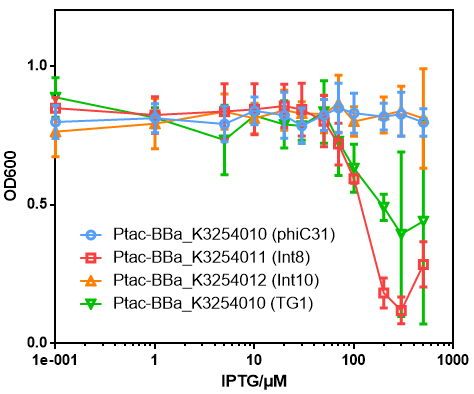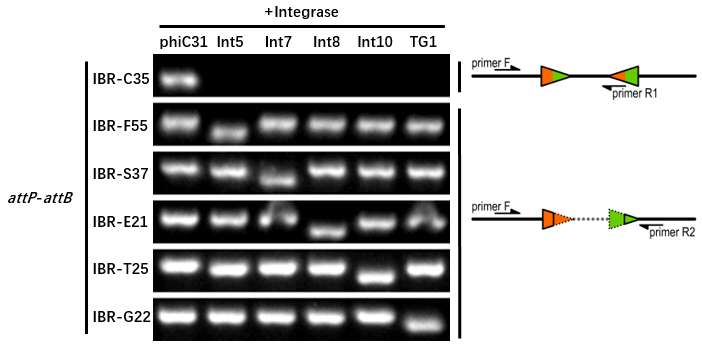Part:BBa_K3254013
Translational Unit for TG1 integrase
This part can be placed downstreamed a prmoter. The thermodynamic characteristics of this part were described in the workframe of a previous study(see reference). The RiboJ(BBa_K2615996) part was added before the RBS-coding sequence, so that the modularity and reuseability would be improved.
- We characterized the thermodynamic characterizatics and toxicity of this part, and the orthogonality between phiC31 and 5 other LSTP using this part.
Thermodynamic Characterization
- The cis-element used in this experiments were BBa_K3254005 which contains the TG1 att sites.
- We constructed an IPTG inducible system to control the expressional level by the IPTG concentration in E.coli DH5α host.
- The distribution ratios of the cells with original att sites or recombined att sites were measured using a flow cytometry.
Genetic Design
- The composition and principle of the experimental system are indicated below. More details can be seen on the pages of BBa_K3254005.
- This part was placed downstream of a Ptac promoter.BBa_K3254025 can be seen as a reference of device structure.
Experimental Setup
The two plasmids were co-transformed into E.coli DH5α host. Then we selected colonies with no observable fluoresce and inoculated into M9 supplemented medium for overnight growth. Then, the cell cultures were diluted 1000-fold with M9 supplemented medium with gradient concentrations of IPTG inducer and growth for another 20 hours. All incubations were carried out using a Digital Thermostatic Shaker maintained at 37 °C and 1000 rpm, using flat-bottom 96-well plates sealed with sealing film. Finally, 3-μL samples each culture were transferred to a new 96-well plate containing 200 μL per well of PBS supplemented with 2 mg/mL kanamycin. The fluorescence distribution of each sample was assayed using a flow cytometry.
Results
- The recombination rate could be controlled by IPTG concentration and has a very narrow hypersensitivity response interval (the grean circle indicate the phiC31 testing group).
- Because the Ptac promoter has a nearly-linear response curve (see BBa_K3254025), it is more likely that the hypersensitivity is due to the characteristics of the integrase itself rather than the characteristics of the transcriptional regulation system.
Toxicity Characterization
- After the 20 hours incubation described in "Thermodynamic Characterization" and before sampling, the OD600 of each well was measured by a microplate reader.
- The differents between the readings of OD600 of each group could be a reference of toxicity characteristic.
Results
- The data points with green color is the results of this part.
- Compared to other groups, significant toxicity could be observed when induced by high-concentration IPTG.
Orthogonality Characterization
We conducted orthogonality tests to see the compatibility between the 6 integrase used in our project. The other integrases include phiC31, Int5, Int7, Int8 and Int10.
Genetic Design
Similar to the design of thermodynamic characterization. Each integrase generator plasmid was co-transferred with 6 plasmid containing different sets of cis-elements.
Experimental Setup
The growth condition is similar to the thermodynamic characterization but every sample were full induced with 500 μM IPTG. Then we used specific primers to identify the genotype of att sites by PCR. The principle of genotype identification was shown on the right of result image.
Results
The result indicate that phiC31 integrase has a good orthogonality with the other 5 att sites and compatible with other integrases. IBR-C35/F55/S37/E21/T25/G22 were the plasmids with phiC31/Int5/Int7/Int8/Int10/TG1 att sites.
Sequence and Features
- 10COMPATIBLE WITH RFC[10]
- 12INCOMPATIBLE WITH RFC[12]Illegal NheI site found at 1834
- 21COMPATIBLE WITH RFC[21]
- 23COMPATIBLE WITH RFC[23]
- 25INCOMPATIBLE WITH RFC[25]Illegal AgeI site found at 1656
- 1000INCOMPATIBLE WITH RFC[1000]Illegal SapI site found at 1870
Illegal SapI.rc site found at 461
Illegal SapI.rc site found at 1622
| None |




